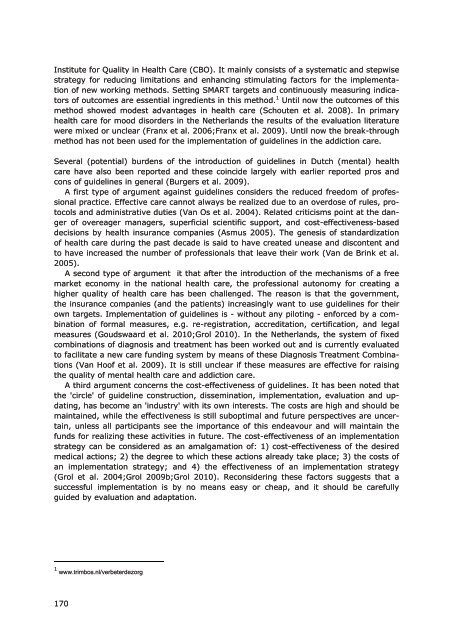The Netherlands Drug Situation 2010 - Trimbos-instituut
The Netherlands Drug Situation 2010 - Trimbos-instituut
The Netherlands Drug Situation 2010 - Trimbos-instituut
Create successful ePaper yourself
Turn your PDF publications into a flip-book with our unique Google optimized e-Paper software.
Institute for Quality in Health Care (CBO). It mainly consists of a systematic and stepwisestrategy for reducing limitations and enhancing stimulating factors for the implementationof new working methods. Setting SMART targets and continuously measuring indicatorsof outcomes are essential ingredients in this method. 1 Until now the outcomes of thismethod showed modest advantages in health care (Schouten et al. 2008). In primaryhealth care for mood disorders in the <strong>Netherlands</strong> the results of the evaluation literaturewere mixed or unclear (Franx et al. 2006;Franx et al. 2009). Until now the break-throughmethod has not been used for the implementation of guidelines in the addiction care.Several (potential) burdens of the introduction of guidelines in Dutch (mental) healthcare have also been reported and these coincide largely with earlier reported pros andcons of guidelines in general (Burgers et al. 2009).A first type of argument against guidelines considers the reduced freedom of professionalpractice. Effective care cannot always be realized due to an overdose of rules, protocolsand administrative duties (Van Os et al. 2004). Related criticisms point at the dangerof overeager managers, superficial scientific support, and cost-effectiveness-baseddecisions by health insurance companies (Asmus 2005). <strong>The</strong> genesis of standardizationof health care during the past decade is said to have created unease and discontent andto have increased the number of professionals that leave their work (Van de Brink et al.2005).A second type of argument it that after the introduction of the mechanisms of a freemarket economy in the national health care, the professional autonomy for creating ahigher quality of health care has been challenged. <strong>The</strong> reason is that the government,the insurance companies (and the patients) increasingly want to use guidelines for theirown targets. Implementation of guidelines is - without any piloting - enforced by a combinationof formal measures, e.g. re-registration, accreditation, certification, and legalmeasures (Goudswaard et al. <strong>2010</strong>;Grol <strong>2010</strong>). In the <strong>Netherlands</strong>, the system of fixedcombinations of diagnosis and treatment has been worked out and is currently evaluatedto facilitate a new care funding system by means of these Diagnosis Treatment Combinations(Van Hoof et al. 2009). It is still unclear if these measures are effective for raisingthe quality of mental health care and addiction care.A third argument concerns the cost-effectiveness of guidelines. It has been noted thatthe 'circle' of guideline construction, dissemination, implementation, evaluation and updating,has become an 'industry' with its own interests. <strong>The</strong> costs are high and should bemaintained, while the effectiveness is still suboptimal and future perspectives are uncertain,unless all participants see the importance of this endeavour and will maintain thefunds for realizing these activities in future. <strong>The</strong> cost-effectiveness of an implementationstrategy can be considered as an amalgamation of: 1) cost-effectiveness of the desiredmedical actions; 2) the degree to which these actions already take place; 3) the costs ofan implementation strategy; and 4) the effectiveness of an implementation strategy(Grol et al. 2004;Grol 2009b;Grol <strong>2010</strong>). Reconsidering these factors suggests that asuccessful implementation is by no means easy or cheap, and it should be carefullyguided by evaluation and adaptation.1 www.trimbos.nl/verbeterdezorg170




